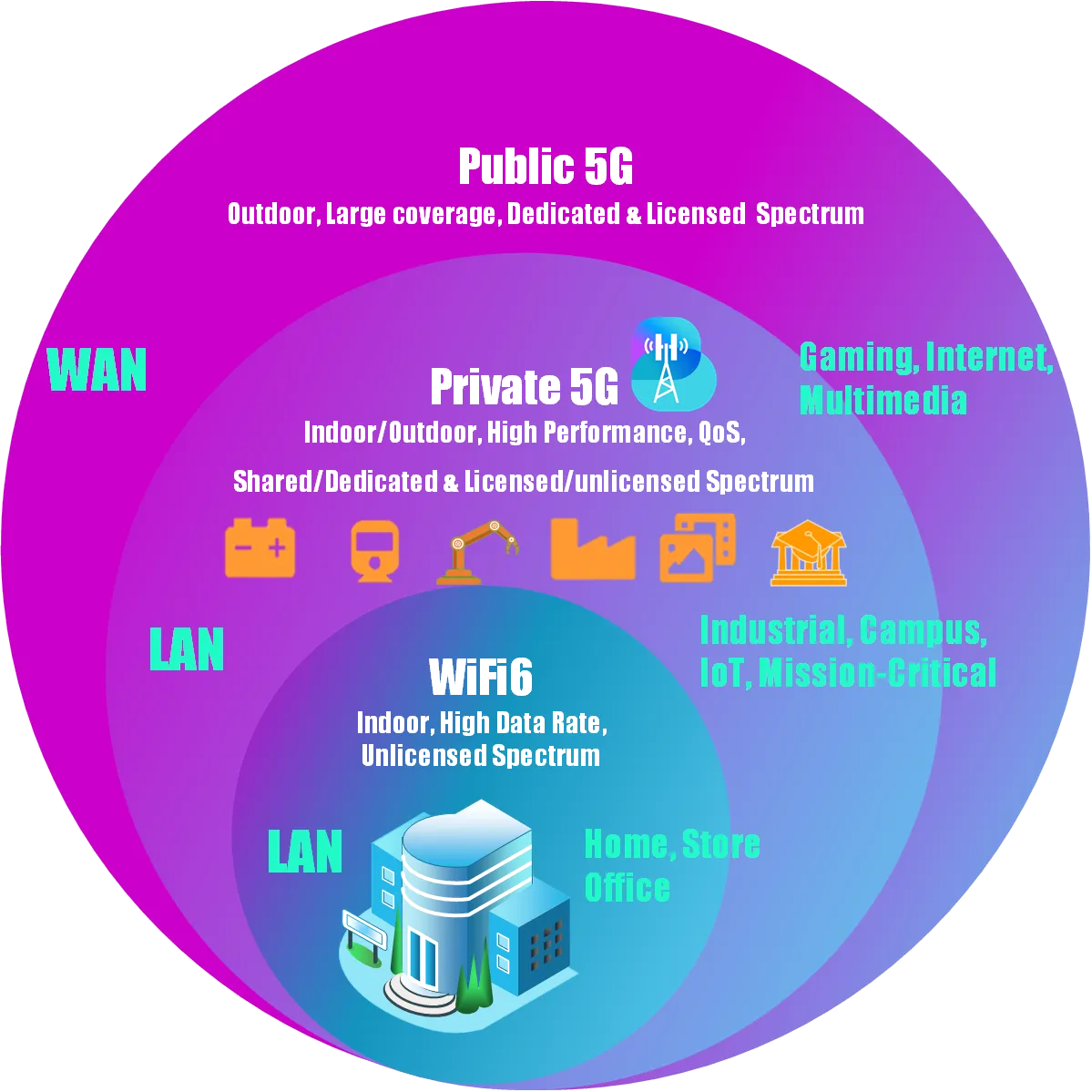Private 5G and Wifi 6 technologies are becoming utilities and re-defining how organizations and enterprises could benefit from wireless connectivity to enable their business applications, and ultimately their use-cases.
While each technology might be the choice for a particular use-case, in many scenarios they could be mixed and matched as complementary to each other either in a form of different silos or coexistence (e.g. WiFi Calling/VoWiFi, WiFi Offloading). The questions is when and where?
Slides: BubbleRAN-P5G-WIFI6
Q1: What is the Problem in the first place?
- Last-mile Wireless Connectivity tailored to each particular use-case requirements!
Q2: 5G or WiFi6: Friends or foe?
- Both! … Well it depends on the use-case. They can complement and compete each other.
- Remember that WiFi calling and WiFi offloading help public network Operators to save bandwidth, reduce operational cost, and reduce network congestion. WiFi continue to act as bridge to and from 5G.
Q3: What is needed?
- A seamless wireless connectivity between 5G and WiFi6 as what happened between 4G and WiFi5!
- A QoS guarantee for industrial use-cases with stringent performance requirements and SLA
Q4: How do private 5G, WiFi 6, and public 5G compare to each other?
- Both private 5G and WiFi provide a local area network (LAN) where as public 5G provides a wide-area network (WAN)!
- Private 5G supports both indoor/outdoor deployment and Licensed/unlicensed Spectrum.
- WiFi6 is mainly targeted for indoor deployment with unlicensed Spectrum.
- Public 5G is mainly targeted for outdoor deployment with licensed Spectrum.
Q4: Private 5G or public 5G for vertical industry networking?
- Have a look at this blog post.
Use-cases & Requirements
Most of the industrial use-cases require performance guarantee (e.g. reliability) coupled with added value services (e.g. localization, identifications). Table below compares 5G and Wifi in view of different use-cases.
| Use-case | Main Requirements | 5G | WiFi 6/6E |
|---|---|---|---|
| IoT | Density, Low Power | ☑️ | |
| Transport | Mobility, Latency, Reliability | ☑️ | |
| AR/VR | Bandwidth, Latency, Privacy | ☑️ | |
| Manufacture | Latency, Reliability | ☑️ | |
| Healthcare | Bandwidth, Reliability, Security | ☑️ | ☑️ |
| Campus/Mining | Reliability, Bandwidth, Localization, Low Power | ☑️ | |
| Connected Robotics | Mobility, Latency, bandwidth, Localization, Identification | ☑️ | |
| e-Mobility | Reliability, Localization | ☑️ | |
| Smart Factory | Reliability, Latency, Bandwidth | ☑️ | |
| Realtime monitoring | Bandwidth | ☑️ | ☑️ |
| Personalized store | Bandwidth, latency | ☑️ | ☑️ |
| Voice/Video IP | Bandwidth, latency, jitter | ☑️ | ☑️ |
| Office/Home | Bandwidth, latency | ☑️ | ☑️ |
How 5G compares to WiFi 6?
There exist many KPI (Key performance indicator related to network) and KVI (Key Value Indicator related to society) to compare 5G and WiFi. Table below focuses on the KPI comparison.
| KPI | 5G | WiFi 6/6E | Comments |
|---|---|---|---|
| Frequency Range | Sub-6GHz (FR1) and above (FR2) | 2.4 GHz,5 GHz,6 GHz | |
| Spectrum Type | Licensed and Unlicensed | Unlicensed | |
| Coverage | Indoor and outdoor (wide range) | Indoor mainly | Depends on the frequency range. |
| Data Rate (nominal) | 10Gbps (up to 20Gbps) | 10Gbps | Depends on many factors. |
| Latency /Jitter | 1-15ms / low | 10-2000ms / high | 5G has much lower variability, |
| Reliability | 99.9999% | Low | WiFi6 is reliable for small area. |
| Device Density | 1000000 per m2 | 100-1000 per m2 | |
| Security | SIM/eSIM | WPA3 | 5G provides a better identification. |
| Mobility | High mobility (700 km/h) | within 1 AP | Depends on the frequency range. 5G also support seamless handover. |
| Slicing / QoS | Yes | No | 5G provides QoS Guarantee. |
| Runtime Control | Yes (Standardized by O-RAN) | Vendor-specific | Enabled via O-RAN 5G RAN Intelligent Controller (RIC). |
| Simplicity | Vendor-specific | Yes | Private 5G is becoming plug-and-play. |
| Compatibility | Medium (Region) | High | WiFi provides compatibility with any devices. |
| Cost | High-Medium | Medium-Low | The higher is the network coverage, the lower is the 5G cost compared to WiFi 6. |
Note that 5G offers higher level of flexibility and fine-grain control for each application and service by means of QFI (QoS Flow Indicator), which in turn provides performance guarantee for each device, each slice/group, or each application flow.
How to proceed?
- Step 1: Identify use-case requirements and its evolution in near future so as to dimension wireless connectivity accordingly
- Step 2: Evaluate application performance under different conditions in an operational environment (TRL 6-7)
- Step 3: Assess the costs for the current deployment and its future evolution
- Step 4: Deploy a small scale network and validate the application performance in the field (TRL 8-9)
- Step 5: Scale the network as the business requirements evolves
